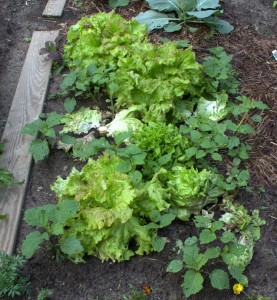With little husk tomatoes you can never harvest them all, there’s just so many. The husk-wrapped fruits fall off the vine when they’re ripe.

A cool thing about all that dropped fruit is that the seeds from some of that old fruit will provide this year’s harvest.
Seeds overwintered on the ground and now they’ve sprouted into small plants. I guess that’s Nature’s way of assuring the species survival from one year to the next.
Many of the volunteers have been hoed or pulled out. As the lettuce gets harvested we’ll get more space for the husk tomatoes to grow. More of them will be culled when the lettuce is removed.
The remaining plants should be starting to flower when the hot weather gets here.
The only thing to watch out for is that you don’t let too many plants grow up in a small area. That will limit the amount and size of fruit. About one plant per square foot is almost too much. These plants do sprawl to cover a larger area, more like 4′ x 6′.
Years ago we found this special heirloom plant at a local greenhouse run by Amish folks. Since then, we’ve enjoyed the husk tomatoes quite a bit.
If you can find a husk tomato or ground cherry plant to add to your garden, you’re luckier than most. It seems garden centers don’t stock such an unusual plant very often, if at all.